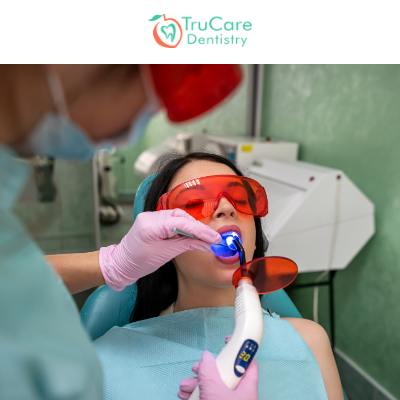
Which conditions can lasers treat? How and which types of lasers do dentists use? Are laser dental treatments safer than old-fashioned ways? You are here to find answers to these and other questions.
Laser dentistry has been around since 1989. Yet, until the last decade, only selected professionals practiced the same. The FDA has approved the use of chosen lasers for dental procedures.
At TruCare Dentistry in Roswell, we often interact with patients curious about laser dental treatments. Thus, we wish to highlight how these procedures are better than traditional approaches.
Let’s take a look at both hard and soft tissue laser procedures:
1. Gum Disease treatment
Periodontal disease is triggered by bacterial infection. Parasites and bacteria are associated with bone loss and gum disease.
The old approach involves cutting away gum tissues consisting of pockets of harmful bacteria. Removal of tissues results in gaps between teeth. Roots turn sensitive. Brushing teeth becomes painful due to the overall sensitivity.
The laser procedure involves an entirely different approach. First, dentists collect gum tissue samples and diagnose them under a microscope. The intention is to check if there’s an active infection. If the presence is detected, surgeons treat the infected areas with lasers. It helps in killing harmful bacteria and shrinking gum pockets.
Laser treatment is less destructive and comfortable for the patient. It’s the most effective technique to stop disease progression. Put simply, the minimally invasive procedure helps control the infection without cutting gum tissues.
2. Laser teeth whitening
Laser method and whitening trays are two widely used tooth bleaching options. The peroxide present in the gel releases oxygen molecules on tooth enamel. These molecules break down stains on the tooth surface within a few hours.
So, what’s the difference between using whitening trays and lasers? The latter option expedites the oxygen release process by heating the molecules. Dentists use an argon laser on bleaching trays to speed up the chemical reaction.
3. Treating tooth decay
Procedures involving regular fillings might trigger pain. So, surgeons administer anesthesia. Thus, patients often shy away from treatment.
The laser removes the pain factor. Endodontists use isotopic CO2 lasers for excavating the decay. As a result, caries excavation and preparation procedures become easy.
The all-tissue laser is fast and reliable. It’s used for working on bone, enamel, dentin, and gingiva.
4. Treating hypersensitivity
The pain associated with dental hypersensitivity is sharp, non-spontaneous, short, and reversible.
The conventional technique involves the use of desensitizing topical agents. Application time is longer. On the other side, laser treatment shows results rapidly. Dentists can finish the procedure within minutes.
Endodontists and laser specialists highlight the concerned area. Then, laser irradiation is performed on the selected areas of the gum and tooth. Professionals may perform laser irradiation for 10 to 20 seconds.
5. Cavity detection
Your toothbrush fails to reach certain parts of the tooth. These areas turn out to be a den of harmful bacteria at a later stage. Thankfully, laser irradiation proves a lifesaver.
A pen-like device emits a laser beam and assists dentists in cavity detection. The treatment can help in controlling decay at an early stage.
The list of laser dental procedures also includes the following treatments:
- Removing tumors from cheeks, lips, gums, palate
- Reshaping throat tissues to treat sleep apnea
- Examining areas inside gum tissues and teeth
- Regenerating damaged nerves, blood vessels
- Treating cold sores
Laser dentistry pros
1. Killing bacteria and promoting tissue growth
The technology has made several procedures comfortable for patients. Lasers do not inflict pain because they seal blood vessels and nerve endings.
There’s no need to cut the gum tissues unnecessarily. Thus, tissue and bone damage is almost zero. Most importantly, bleeding is lesser compared to traditional surgical procedures. Plus, the laser stimulates stem cells and regenerates the lost bone and ligaments.
2. Superb option for kids and anxious adults
In some cases, anesthetics can result in allergies. Unfortunately, both children and adults can face complications.
Laser dental procedures prove to be the best option for such individuals. Your surgeon won’t administer anesthesia in most cases. Thus, no question of allergies.
3. Considerably lesser time for recovery
Laser dentistry has considerably reduced recovery times for many processes. Minor healthy tissue damage also reduces the chances of infection. Dentists do not use scalpels, so there’s no need for sutures. These factors help your mouth to heal quickly. That too, without consuming antibiotics post-surgery.
What about the disadvantages of dental lasers?
Patients with dental bridges, crowns, and metal fillings are ineligible. Some laser treatments are costly. In addition, incorrect use of lasers can cause tooth pulp damage.
The benefits certainly outweigh the disadvantages. You won’t have to worry if you choose experienced dental care professionals for the treatment.
Laser specialists choose the wavelength and type of light-emitting device carefully. Both dentists and patients have to wear protective eyewear. Dental offices take all the special precautions to ensure safety.
Here’s a quick look at the most widely used types of hard and soft lasers:
- CO2
- Nd:YAG
- Diode
- HO:YAG
- Er:YAG
- Er,Cr:YSGG
- Argon
To sum it up:
Dentists know precisely how to adjust the laser to cauterize, vaporize, or cut the infected tissue. So, there’s no need to think about those noisy dental drills, pain, or discomfort anymore. Do you wish to opt for laser dentistry procedures in Roswell (GA)? Feel free to connect with us and fix an appointment at TruCare Dentistry.
